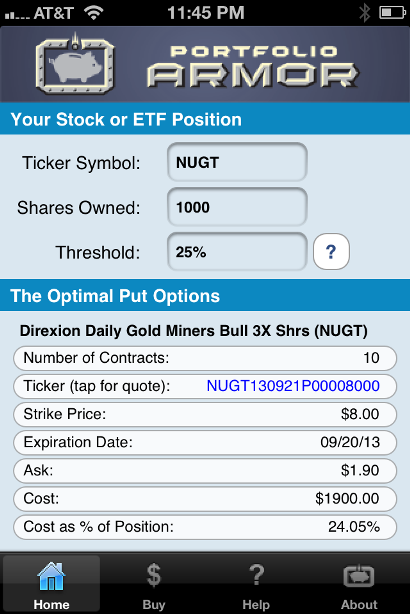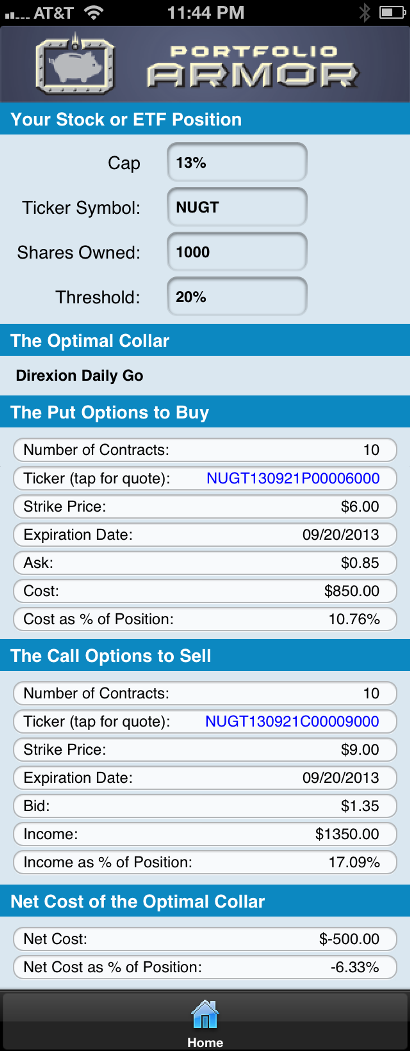The Appeal Of Gold
Investors wary of a weakening dollar have long been drawn to gold. The supply of dollars is determined by Federal Reserve policy, which can vary widely, but increases in the supply of gold are constrained by mainly by how much of it can be mined, and global gold mining production has been quite steady since 1997, averaging about 80 million ounces.
The Appeal Of Gold Mining Stocks Versus Gold
For investors who are bullish on gold, the inherent operating leverage of gold miners can make gold mining stocks such as Barrick Gold Corporation ABX and Goldcorp, Inc. GG attractive: as gold prices rise higher above gold miners' fixed costs of production, miners' profits can rise faster than the price of gold itself.
Diversifying Against Stock-Specific Risk
Investors who want to diversify the stock-specific risk of investing in gold miners can do so buy buying a basket of mining stocks, either directly, or via an ETF such as the Market Vectors Gold Miners ETF GDX, which includes Barrick Gold and Goldcorp as its two largest holdings.
Adding Leverage
Gold investors who want to add leverage to their portfolios can consider the Direxion Daily Gold Miners Bull 3X Shares ETF NUGT, which holds the Market Vectors Gold Miners ETF and seeks to return 300% of the daily movement of the NYSE Arca Gold Miners Index.
The Downside Of Leveraged ETFs
The downside of leveraged ETFs is their potential downside: we're just about six weeks into 2013, and unhedged NUGT longs who bought the ETF at the beginning of the year are already down more than 29%, as of Tuesday's close.
Reining In The Risk Of A Leveraged Gold Miner ETF
As we noted in a recent post, hedging a security against a greater-than-20% drop can offer a reasonable compromise between limiting downside risk and lowering the cost of hedging. Unsurprisingly for such a volatile ETF (as of Tuesday, the 52-week high and low prices on NUGT were $26.69 and $7.62, respectively), its puts are expensive. On Tuesday, NUGT was too expensive to hedge against a greater-than-20% drop using optimal puts*. That's because the cost of hedging it against a greater-than-20% drop over the next several months was itself greater than 20% of position value.
The smallest decline threshold against which it was possible to hedge NUGT on Tuesday over that time frame was 25%. These were the optimal puts to hedge 1000 shares of NUGT against a greater-than-25% drop by September 20th, as of Tuesday's close:

As you can see in the screen capture above, the cost of those optimal puts, as a percentage of position, was almost as high as that decline threshold: 24.05%. It's hard to imagine any investor would want to take a 24% hit to hedge against a >25% drop.
Just as NUGT's puts were expensive on Tuesday, though, so were its calls. By combining the right long puts and short calls on NUGT into a collar, an investor could have dramatically lowered his hedging costs.
Not Too Expensive To Hedge With Optimal Collars
A NUGT investor interested in hedging against a greater-than-20% decline between now and September 20th, but also willing to cap his potential upside at 13% over that time frame, could have used the optimal collar** below to hedge 1000 shares on Tuesday instead.

As you can see at the bottom of the screen capture above, the net cost of this optimal collar is negative -- meaning the NUGT investor would be getting paid to hedge in this case, an amount equal to 6.33% of his position value.
Calculating Net Cost Conservatively
It's worth noting, that, to be conservative, the cost of the puts above was calculated using their ask price, and, also to be conservative, the income from the calls was calculated using their bid price. Since, in practice, an investor can often buy puts for less than their ask price (i.e., some price between the bid and ask), and an investor can often sell calls for more than their bid price (again, for some price between the bid and ask), a NUGT investor opening this optimal collar on Tuesday would likely have been paid more than 6.33% of his position to do so.
Worst Case Scenario
For the purposes of this example, we'll assume our hypothetical investor just got paid 6.33% of his position to open that collar. What's his worst case scenario? That would be his NUGT shares dropping by more than 20%. If that happened, the investor's losses on the ETF would be limited to 20%, but remember, he made 6.33% when he opened that collar. So, taking that into account, his worst case downside here would be a net loss of 13.67%.
Best Case Scenario
The best case scenario for an investor who opened this collar would be for NUGT to rise 13% or more. If that happened, the investor's NUGT shares would get called away, so his upside there would be capped at 13%. But add in the 6.33% the investor made when he opened the collar, and he would have a total gain of 19.33%
*Optimal puts are the ones that will give you the level of protection you want at the lowest possible cost. Portfolio Armor uses an algorithm developed by a finance Ph.D to sort through and analyze all of the available puts for your stocks and ETFs, scanning for the optimal ones.
**Optimal collars are the ones that will give you the level of protection you want at the lowest net cost, while not limiting your potential upside by more than you specify. The algorithm to scan for optimal collars was developed in conjunction with a post-doctoral fellow in the financial engineering department at Princeton University.
The screen captures above come from the latest build of the soon-to-come 2.0 version of the Portfolio Armor iOS app. Optimal collar capability will be available as an in-app subscription in the 2.0 version of the app.
© 2024 Benzinga.com. Benzinga does not provide investment advice. All rights reserved.
Comments
Trade confidently with insights and alerts from analyst ratings, free reports and breaking news that affects the stocks you care about.